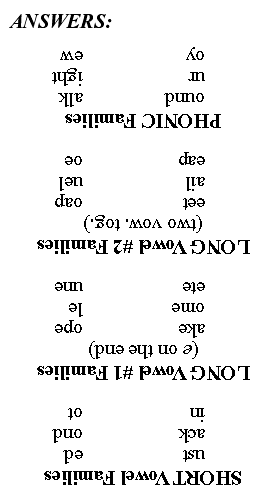 The #1 sign of homeschool success is a child who can read fluently and
well. Nothing equals the thrill of teaching your own child to read, or
seeing him or her reading the encyclopedia on their own for the first
time!
The #1 sign of homeschool success is a child who can read fluently and
well. Nothing equals the thrill of teaching your own child to read, or
seeing him or her reading the encyclopedia on their own for the first
time!
Now, how can homeschool parents achieve the satisfying result of a
houseful of fluent readers?
I receive calls all the time from parents across the country who are
trying to teach their children to read. They confide in me that they
have not achieved the results they had expected with their phonics
instruction. Their main concern: their children are bored or turned off
by overly complicated, confusing phonics methods.
The Two Phonics Obstacles
In this article, I would like to share a short-cut, easily incorporated
phonics technique. This technique will allow you to steer safely around
the two major problems encountered when teaching phonics:
- Some children have developed the habit of sounding-out controlled
sentences letter-by-letter, such as “Pat and Sam ran and ran,” and
attempt to sound-out natural sentences letter-by-letter, such as “Once
upon a time there were three little bears.” Sounding-out doesn’t work,
of course, because English can’t be understood letter-by-letter.
- Most children do very well with phonics at first, when they learn
one sound for each consonant, digraph, and vowel. These children can
independently decode a multitude of one-syllable words containing these
sounds, such as cat, bed, chin, got, sun, etc. However, English is an
inconsistent language. Eventually, we must introduce alternate sounds
for some consonants and digraphs and many alternate sounds for the
vowels. The following are a few examples of what children must learn:
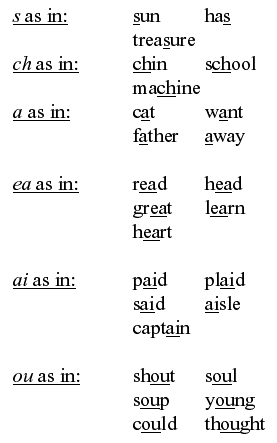
. . . and the list goes on—constantly challenging rather than
reinforcing basic instruction. Rather than getting an immediate response
from your child to each letter or letter-combination, you get immediate
hesitation and confusion—and the problem gets more serious with more
information.
Sight Word? Or Sound-It-Out Word?
If this isn’t bad enough, SIGHT words add more confusion. For example,
the child learns, “The word “once” is a SIGHT word because you can’t
sound it out. Therefore, you have to memorize it whole.” Instruction
continues along this pattern: “Here’s another SOUND for this—but here’s
another SIGHT word. There’s another SOUND for that—but there’s another
SIGHT word, “etc.
So, what happens when your child tries to read? As a result of this
bizarre teaching method, most children can’t
retain the mountainous, conflicting information. But even if they could
retain it, they would still be frozen by indecision—“What SOUND does
this have this time or is it a SIGHT word?”
When you consider these problems, it’s easy to understand why some
children experience difficulty in learning to read—and why some parents
have difficulty convincing their children to get with the program.
How to Avoid Phonics Overload
I will teach you an easy way to avoid these problems. Here’s the key:
TEACH ONLY THE RELIABLE FACTS. This means teach just one sound for each
letter or letter-combination—no exceptions. What will this accomplish?
- You get an immediate response to each letter or letter-combination
because only one sound is known.
- It covers about 90 percent of the phonics information needed to
read.
When students have 90 percent of the phonics information they need to
read at their fingertips, they can easily figure out the exceptions on
their own. When we attempt to teach that small 10 percent of exceptions,
we confuse 100 percent of the words.
Following is the 90 percent reliable phonics information needed to read.
Teach only one sound for each letter or letter-combination as given in
the key word:
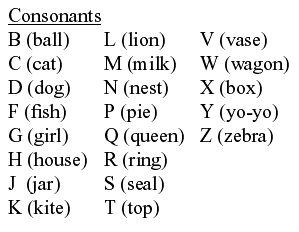
Consonant Blends
Teach your child to blend the following, consonants. This will provide
the skill to blend any other consonants:
bl, br, cl, cr, dr, fl, fr, gl, gr, pl, pr,
sc, scr, sk, sl, sm, sn, sp, spr, st,
str, sw, tr, tw
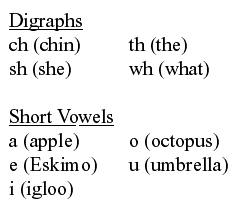
Long Vowel Rules
(1) “e” on the end makes the vowel long.
Ex. ate, ete, ite, ote, ute
(2) When two vowels are together, the first one is long and the second
one is silent.
Ex. ai, ea, ee, ie, oa, oe, ue, ui
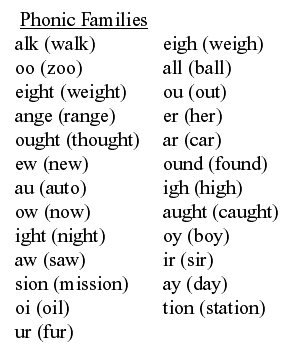
Four Phonics Families
Teaching only this reliable phonics information will enable you to avoid
the above reading problems because children won’t get locked into
sounding-out every word letter-by-letter. With no exceptions taught, we
make an “inconsistent” English language “consistent.”
Now we can divide the entire English language into four clear-cut
groups, which we will call “families.”
- Short Vowel Families.
This includes all families with one vowel.
Ex. at.
- Long Vowel Families #1
(e on the end). This includes all families
with e on the end. Ex. ate.
- Long Vowel Families #2
(two vowels together). This includes all
families with two vowels together. Ex. ait.
- Phonic Families.
This includes the 25 phonic families listed
above. Ex. ay.
Let’s test your technique. See how quickly you can place the following
families under their correct headings below. Then check your answers
with the answers at the end of this article. This will give you a clear
perspective on just how easy the next step will be:
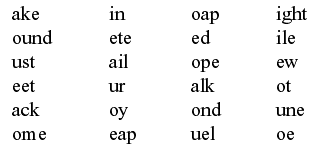
SHORT Vowel Families
______________________________
______________________________
______________________________
LONG Vowel #1 Families
(e on the end)
______________________________
______________________________
______________________________
LONG Vowel #2 Families
(two vow. tog.)
______________________________
______________________________
______________________________
PHONIC Families
______________________________
______________________________
______________________________
We can now decode words by these family units (the actual phonetic
structure of our English language) rather than letter-by-letter. For
example:
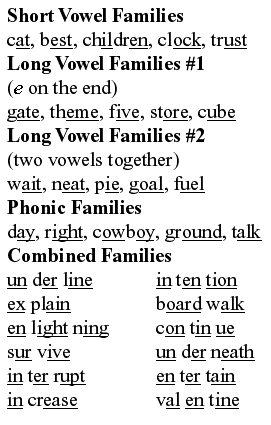
Children won’t get submarined by a mixed bag of phonics rules and sight
words because now every word can be decoded phonetically in exactly the
same way. Children will simply decode every word from left to right by
family units.
What About Exceptions?
No doubt your next question is, “How do the children handle words which
are exceptions to the 90 percent of reliable phonics information?”
Another simple solution. The children will know immediately when they
hit an exception because they will come up with a “nonsense” word. Ex.
said, was, come, give, head, laugh, once. How do they handle these
exceptions? They simply “twist” the mispronunciation of these words into
the meaningful context of the sentence. And what if they can’t “twist” a
particular word into the meaningful context of a sentence, you ask? They
simply look up these few words in the dictionary. Next to each word,
they will find the phonetic respelling. Ex. (sed), (wuz), (kum), (giv),
(hed), (laf), (wuns).
Therefore, there’s no hesitation or confusion—the children decode every
word exactly the same way. They know exactly what they’re dealing with
at all times (a phonic word or an exception), and they know exactly how
to handle an exception (“twist” it into the context or look it up).
Consequently, there are no traps. They’re at the top of their
game—success!
